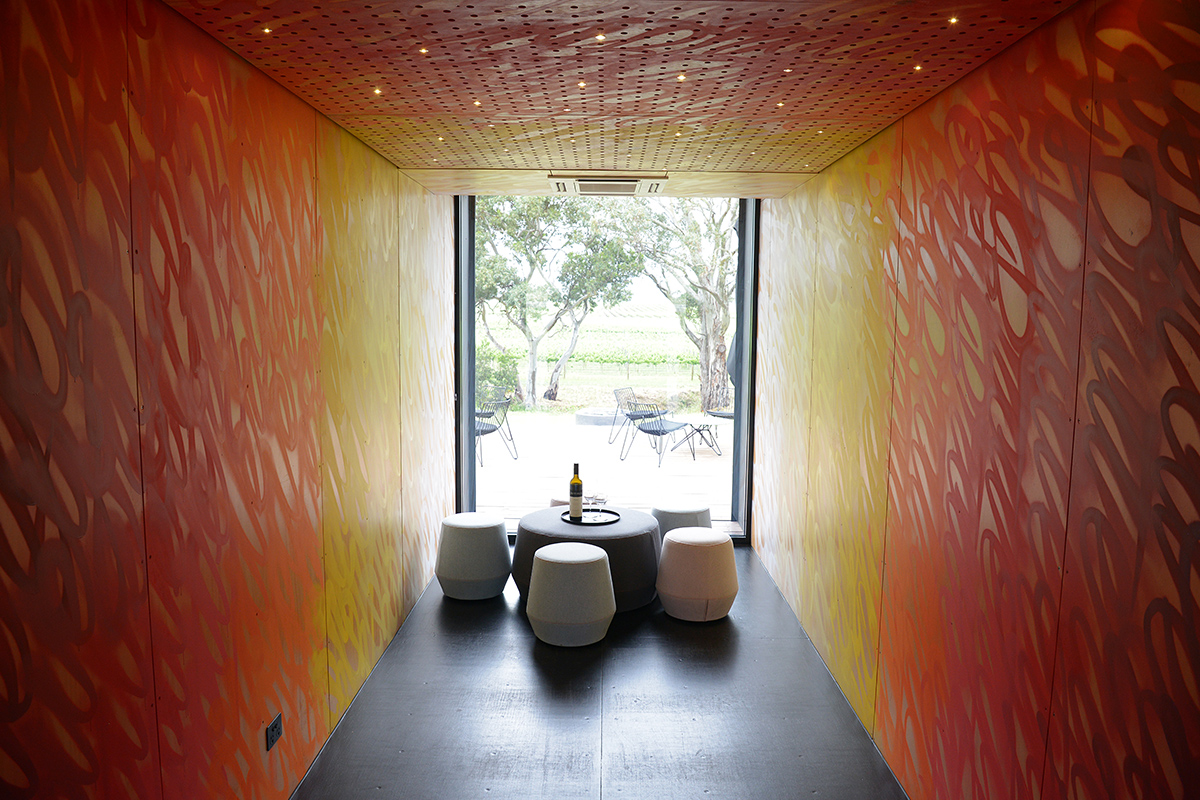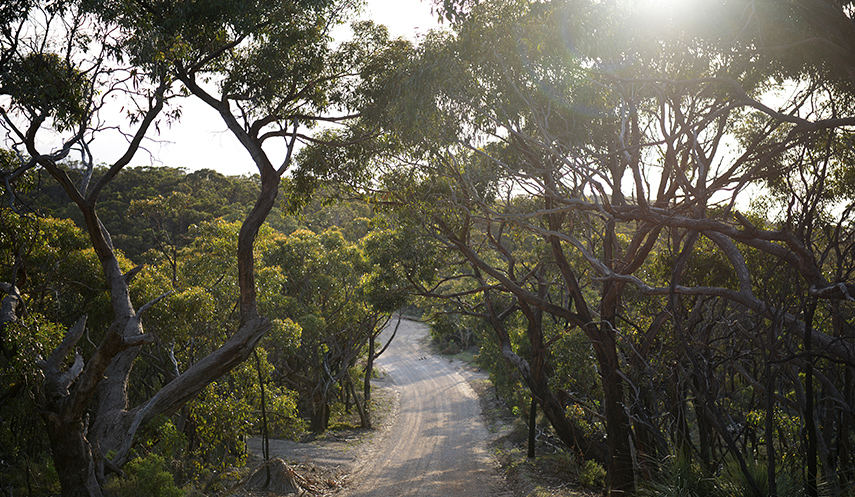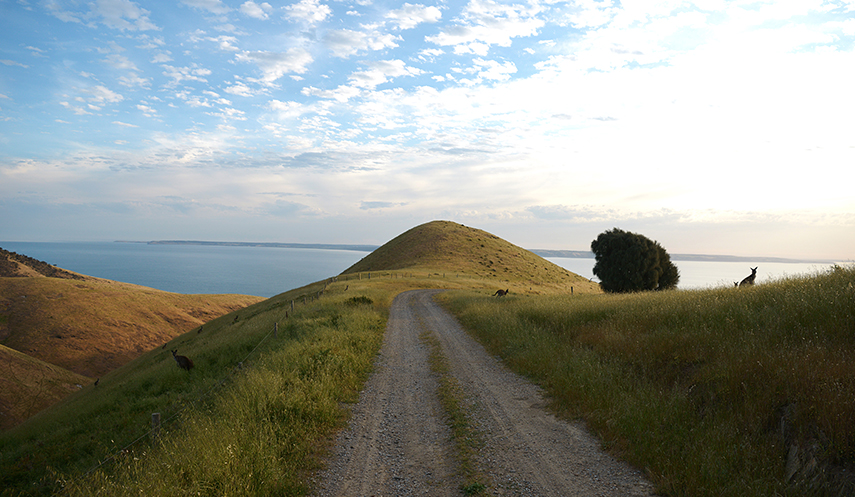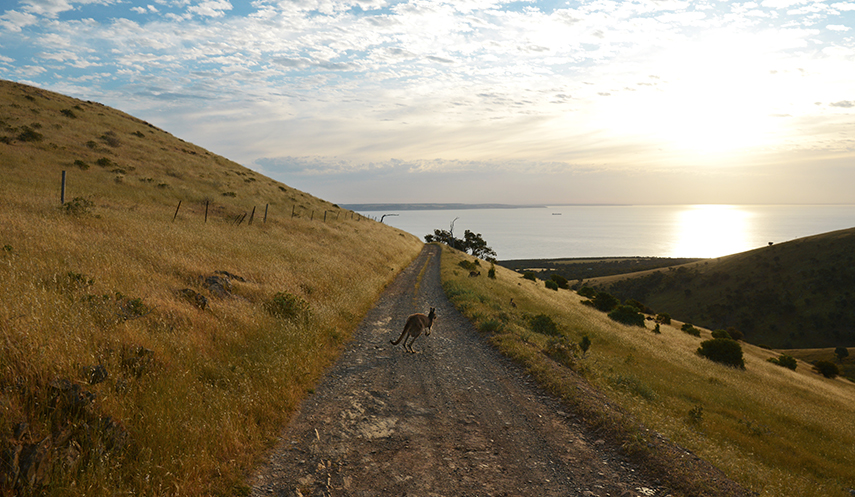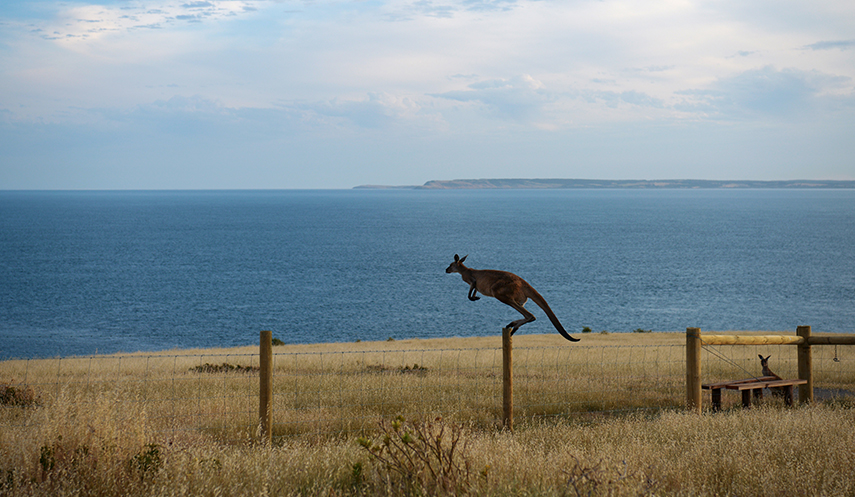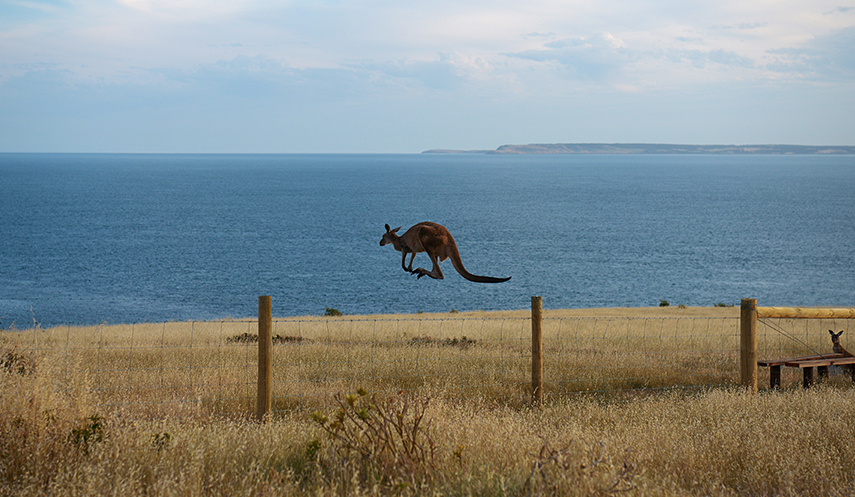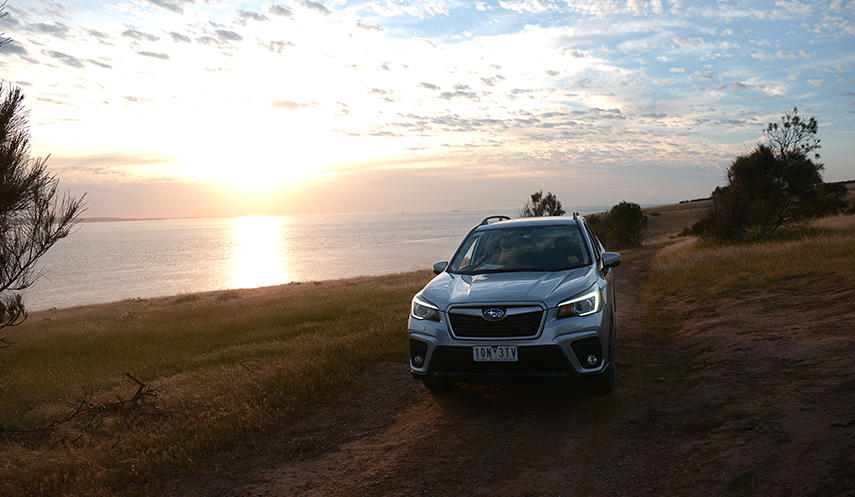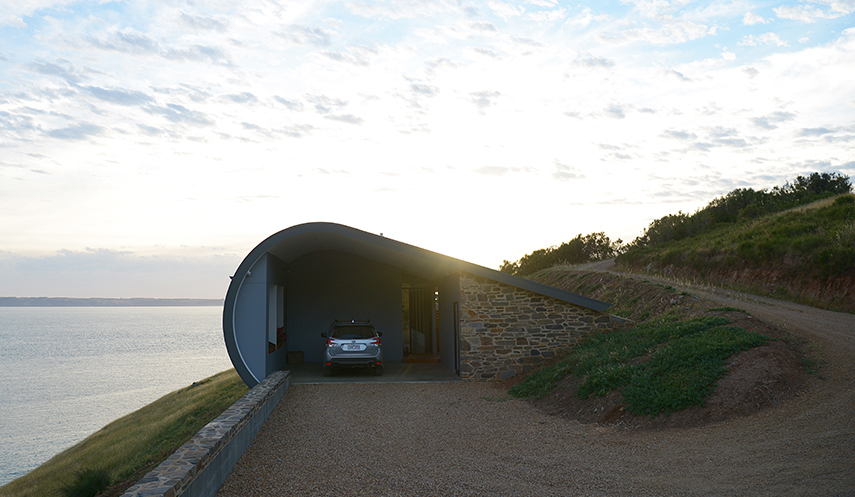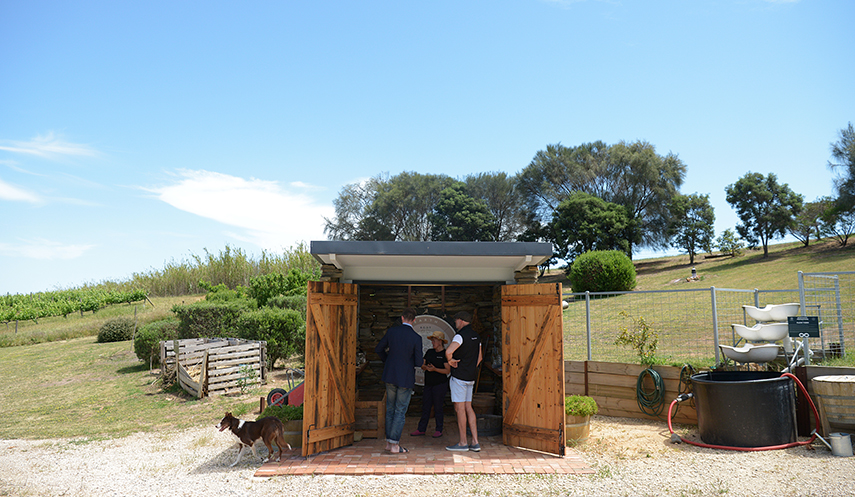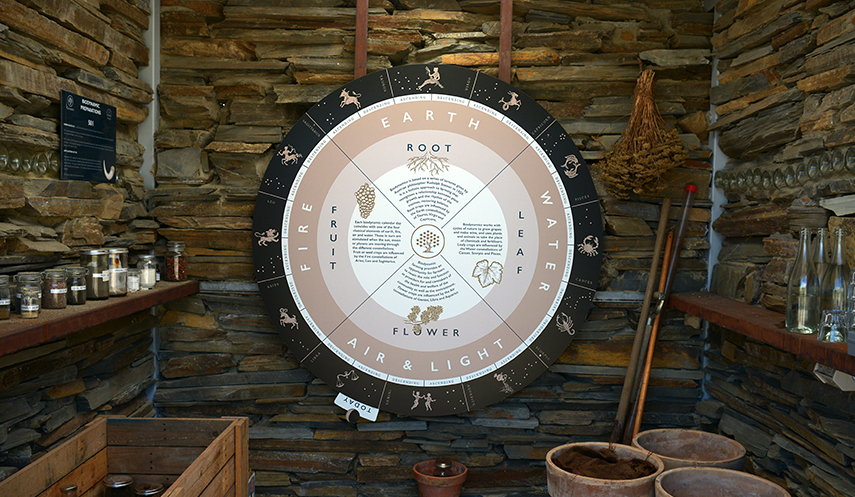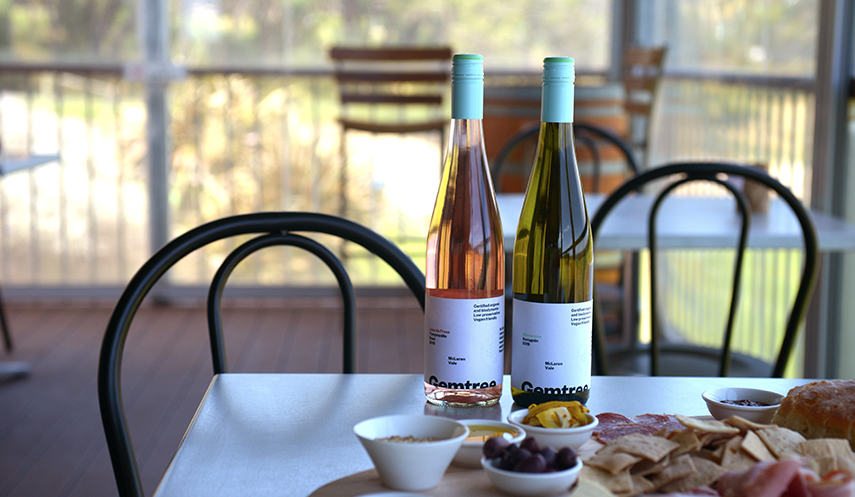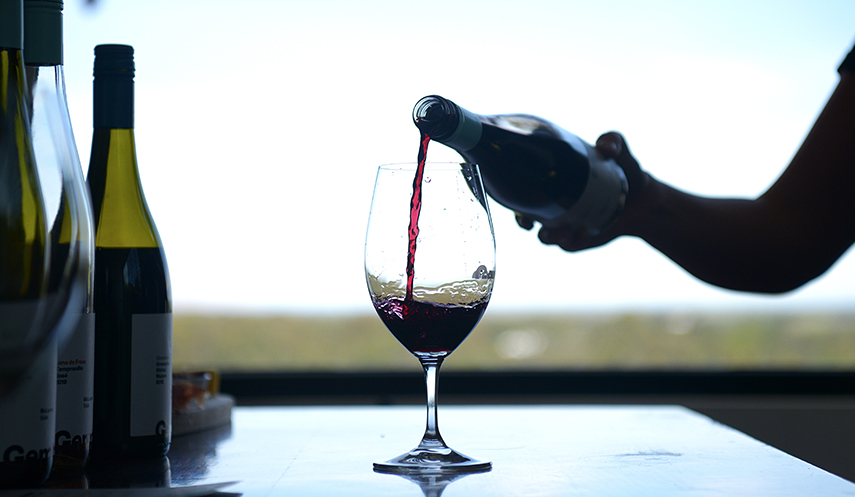Travel series: To Party Town and back via recovery road
Get the hell out of the city this summer. Pack the car. Hire a car. Buy the beer and wine before you leave. Get it on the way – do whatever you need to – but don’t sleep on seeing South Australia’s renewed and reimagined regions. As our publisher discovered, there are worlds within worlds out there and new narratives emerging from the towns you might think you know, but we can categorically tell you, have all changed for the better.
With very little notice and even less planning, you can take off for one or several of the incredible microclimates of South Australia’s regions and entirely forget about the hot urban mess this city melts into every January.
Of course, it’s easy to write that sentence after the trip I’ve been on.
So I should offer a disclaimer: I didn’t know our regions were incredible, or that this state really had anything other than an utterly belligerent lack of moisture in its soil until this trip.
The truth is I likely would have spent the rest of my life blissfully ignorant of our regions climatic differences, had the South Australian Tourism Commission not invited me to visit them.
“Go to Mount Gambier,” they said.
“Why?” I thought. Everyone knows there’s only one region worth visiting in South Australia.
I spent my summers on Yorke Peninsula. It was Mum’s idea to buy a weatherboard shack and cart it down the boot-shaped peninsula on the back of a semitrailer. She was convinced my brother and sister would never get any time with our dad if she didn’t force him to leave the city and put some serious distance between he and his best mate Lou Ravesi.
Mum and Dad have been married 52 years. And I think that shack they bought 40-odd years ago has a lot to do with that fact.
Before this trip to Mount Gambier, I’d only been to Yorke Peninsula, Kangaroo Island, Whyalla (for SAPSASA cricket), Port Pirie (for the 1996 State District Soccer Championships), Mimili (for an Indigenous immersion trip as part of a high school subject) and passed through Robe (on the way to Falls Festival in 2006).
Since 2009, however, and as an adult, I’ve hardly left postcode 5000. Apparently fun’s changed in our regions and I needed to take another look.
Day one
After picking up the hire car from North Terrace, the photographer from Brooklyn Park and a Hungarian goulash pie and chilli cheese dog from Mile End, there was nothing but bitumen and blue sky between Mount Gambier and us.
We had a three-day trip planned. First stop Mount Gambier, then a drive up the Coorong and down to Deep Creek for a night at Naiko Retreat with day three spent eating and drinking and faffing about in McLaren Vale.
We made The Mount by 3PM on the first day. The change in climate and conditions between Naracoorte and Nangwarry and then on to Mount Gambier were astonishing. Things I would never have cared about as a teen – like relative aridity and humidity, trees, monocultures and protected parks full of biodiversity – were all counted in my head. I guess what’s fun had indeed changed for me.
I called the hotel to make sure we could check in at any time and, with the green light, headed back out of town – south – for a swim.
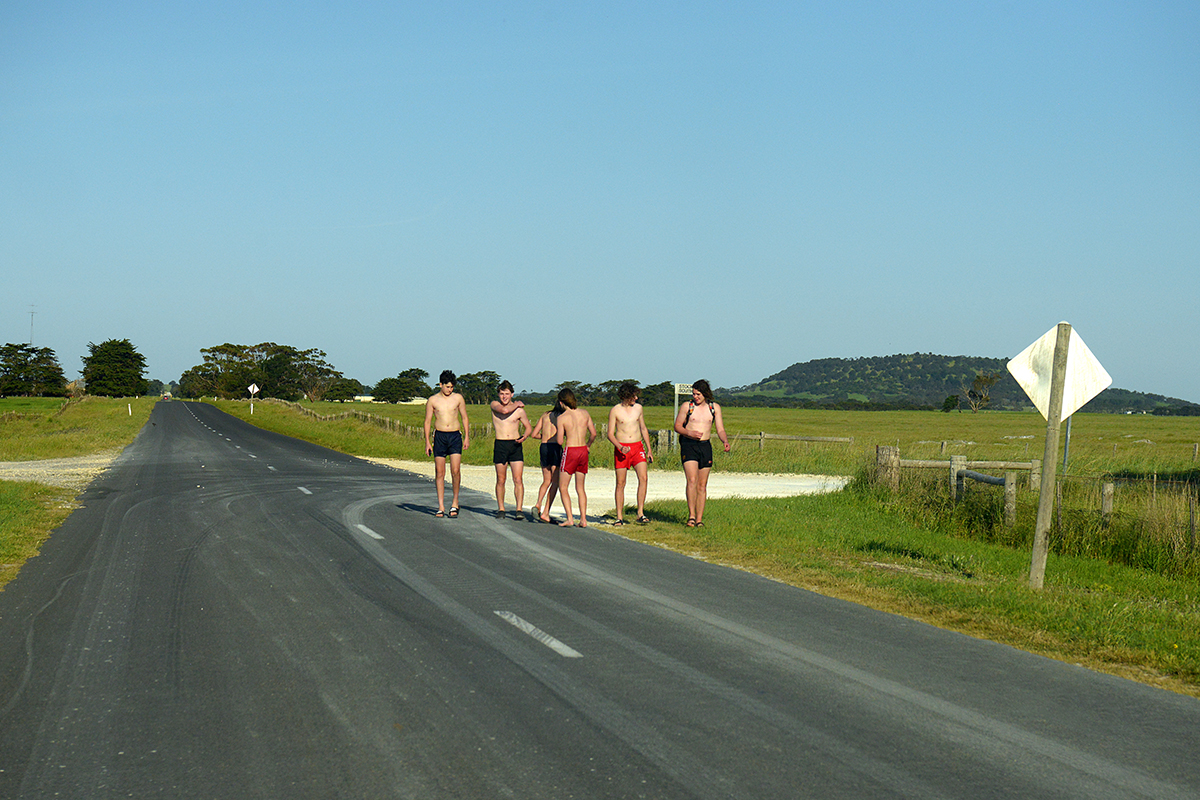

Twenty minutes south of The Mount you turn right at the Bellum Hotel on Mount Salt Road. This long straight road, flanked by pasture on either side, doesn’t look like the place you’d find a natural swimming hole. However, the gang of five-or-so boys we spotted walking along the side of the road – shirtless and shoeless – indicated we were somewhere close.
“They call that spot nails, because of the big, gnarly, steel nails sticking out of it,” said a boy we guessed to be about 13 years old. “Nails” was only one spot of many you could jump from. The best spots all had names.
We watched him roll up to Little Blue Lake on his BMX, promptly park it under a tree by the lake’s edge, ditch his shirt, kick off his slides and immediately head for the cliff.
Little Blue Lake is part of the giant aquifer system surrounding Mount Gambier. It’s about 45 metres deep and the fresh water doesn’t smell. It’s a straight up marvel.
I watched the boy rock back on his heel, coiling his other leg like a spring and – woosh – jump out over the edge. Before hitting the water, we noted his form – how he clapped his hands against his thighs and pointed his toes – cutting straight through the surface of the water. Thuwip! “I’ve got to try that,” I say to myself.

Geronimo!
When my feet finally left the cliff’s edge and the water surface rushed up at me, I noted the weightless feeling of my body mere milliseconds before hitting the water. It’s the same exhilarating feeling I had when jumping off the 7.5 metre platform at the Adelaide Aquatic Centre as a kid.
Turns out what’s fun has also stayed the same.
The photographer and I stayed longer than we should have and could have spent the whole day at Little Blue Lake. It’s a place for locals and visitors alike. A family with British accents were happy to bob about in the clean, cool water, while another local boy – about 10 years of age – got his mother to film him jumping off the biggest cliff opposite the pontoon.

Definitely an album cover in this photo. The photographer and I estimate the cliff to be around 5.5 metres high. Very fun.
“You must be proud,” I said to her as she checked the footage after her son’s jump.
“Oh, it isn’t the first time,” she responded with a distinct air of pride.
The whole scene has a party-like atmosphere as the natural endorphins and adrenaline of both jumping and watching others jump from the cliff top heightened our enjoyment of this special place. Some drank beer, others – water, but everyone dipped at least a toe in this millennia-old lake.
Sitting there and watching the sun arc overhead I recall friends’ photos of them jumping from cliffs into the Mediterranean on their Italian vacations and how they made me jealous. And yet all the while, right here in the South East of our state, is a spot just as stunning and maybe even more unique, because it’s ours.
We learnt more about the unique aspects of region when we called into the Bellum Hotel after our swim.
A solitary building on the side of the Riddoch Highway, the photographer and I thought the Bellum Hotel would be a quaint if not ironic place to grab a cold beer after a little too much time in the sun.
Inside we were pleased to discover an array of locals – all weathered by outdoors work. With a few beers under their belt, they were full of cheer and chatting.
Of course it quieted down some upon our entrance, but when we spotted the air hockey table in the corner and took out the camera to snap it, the oldest man spoke up.

When you see an Air Hockey table in the wild, you play it. Simple as that.
“You boys backpackers?” he asked.
“Sort of,” I replied.
“We’re journalists. We’re writing about the region, about what to see and do in the south east,” I elaborated.
Well then we absolutely had to go to Woakwine Cutting. I had to get him to spell that for me. Beachport was the absolute best town, according to another man (this caused a guffaw among his fellow drinkers). There were more suggestions too, but the group was clear on one thing – we’d need at least seven days to see it all.
We had only allowed 24 hours in Mount Gambier as part of a three day trip that took in The Mount, Deep Creek and McLaren Vale.
24-hours was time for a couple of bombs off the cliffs at Little Blue Lake, a quick game of air hockey and a cold beer at the Bellum Hotel, and now we needed to check into our hotel before catching a gig at Morrison’s Jazz Club.
We arrived at the Mount Gambier Hotel at 7:00PM.
The sun was still warm, but hung low on the horizon by then. We’re checking in even later than expected this evening because the police pulled us up on the main road into Mount Gambier.

I’d spied an architectural marvel; a sort of Mid-Century-cum-brutalist building I assumed was a church and fanged a U-bolt. I parked the car adjacent the building and the photographer quickly jumped out and got to snapping.
The building’s hard edges and smooth curves – it’s high windows and octagonal shape – all looked resplendent in the golden hour before sunset.
But it turned out the building was Mount Gambier’s Magistrates Court, and not a church, and the police were rather bemused by our behaviour.
“We’re just curious is all,” said the police officer after detecting the photographer’s hostility, “as to why anyone would want to photograph such an ugly building.”
I think I was more offended by the cop’s contrary aesthetic than by the fact we had to explain ourselves, open our car boot, and hand over identification. But ignoring my civil rights for a second, I was able to see a bit of myself in this cop’s attitude.
“Why would anyone want to holiday in Mount Gambier?”
The truth about Mount Gambier though is that it’s beautiful. The architecture (not just the courthouse), the youth jumping off cliffs, the coffee and the food are all different to what you’d expect. The place has changed and yet you can’t see it, if you don’t take a look for yourself.
After the cops and after the check-in at the Mount Gambier Hotel – where it looked for a second like the photographer and I would be sharing a bed, until we discovered a second booking under his name – we took our powerful hunger in search of some quality grub.
Walking down Commercial Street East, we hit upon a sign that looked like it had been designed by Carlo Jensen. Indeed, Cosmopolitan Pizzeria & Pasta Kitchen could be the father of Sunny’s Pizza on Solomon Street. Timber cladding to waist height, vinyl surfaces and wooden benches with a hint of pink on the roof and walls set a delicious scene for an authentic pizza experience in Mount Gambier.
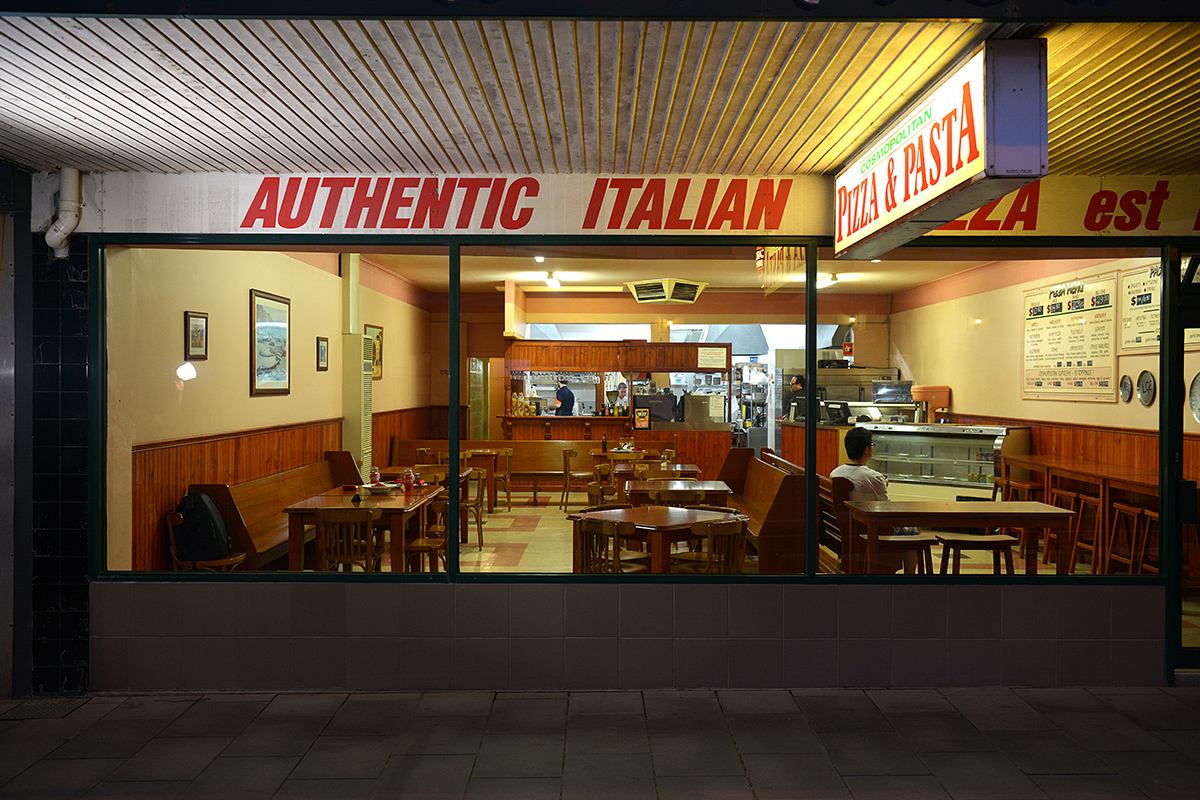
Turns out Cosmos – as it’s affectionately known – is one of the oldest pizza bars in South Australia. Established in 1968, it’s just been inducted into the Mount Gambier Chamber of Commerce “Hall of Fame”.
“They call me the Pizza Nazi,” said Dario Caiazza owner of Cosmos. But the chill of that rather flippantly-delivered biography was warmed up and forgotten once we mentioned how much his restaurant reminded us of Sunny’s Pizza back in Adelaide.
“Oh yeah, my sister lives in Adelaide and she wants to take me there. She said it reminded her of this place,” said Dario.
Cosmopolitan Pizzeria and Pasta Kitchen epitomises the delight of dining regionally. Dario took time to sit with us as we ate and shared the story of his father establishing the restaurant and the big role his dad played in the Italian community in the south east of the state. Dario’s dad passed away a year ago last week.
Dario took out his phone, scrolled to the spot and showed us a photo. His dad is incredibly handsome and his mother looks like a movie star.
“I can do a lot more than what’s on the menu too,” said Dario, before turning to a less sentimental topic.
“We do an excellent calzone– all you need to do is ask. We make our pasta to order too, so you can add or take out anything you want, so long as it’s on our menu.”
The food was ace and the aesthetic was hot at Cosmos. The photographer – a co-owner of Sunny’s Pizza himself – was particularly besotted with the place. But I bet that local cop doesn’t think Cosmos is beautiful like we do.
We ate our fill (more than) and thanked our host. He shouted us two cans of Coke and we told him we’d take him out to dinner at Sunny’s if he was ever in Adelaide. Dario said he’d hold us to that promise.
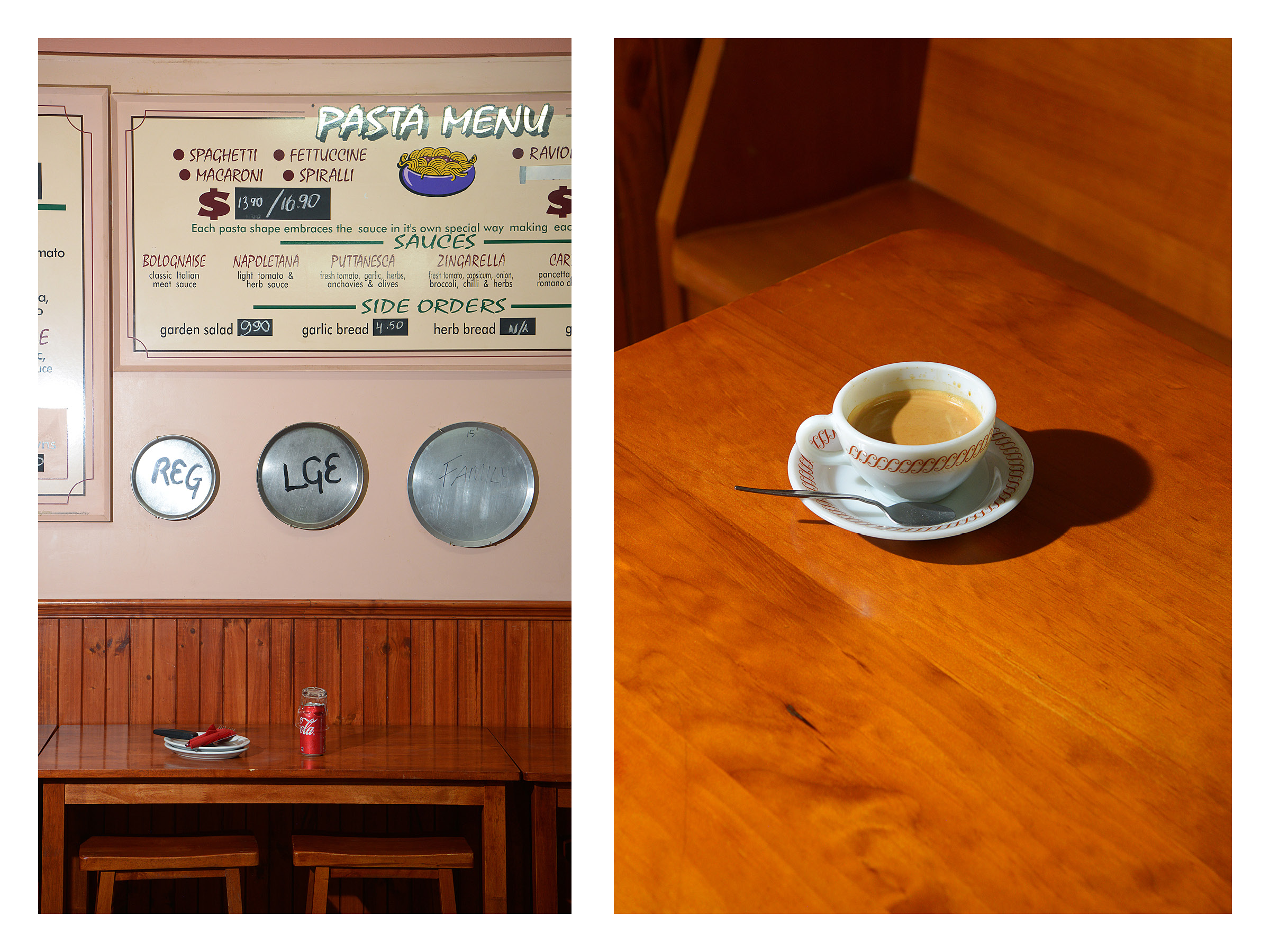


The jazz started at 8:00PM, but it didn’t feel like we were late when we arrived at Morrison’s Jazz Club after 09:00PM.
A large ensemble playing hits with a Las Vegas sound was on the stage – brass-led and loud. Young people hung by the back of the room, around the bar. We noticed a couple of young men had bottles of Corona but, for the most part, the group had glasses of water in front of them.
Whether they were drinking water or beer though, they were all hollering and whooping as the band played on stage and the emphasis shifted between the solo moments of the song.
It was a Tito Puente number and it sounded sassy as fuck. The whole room pulsed with the Latino rhythm.
“We have a rotating gig list every three weeks,” venue manager Dan Caton shouted over the din of the club as he passed us an ice-cold margarita. Dan went on to reveal he’s a graduate of the James Morrison Academy of Music in Mount Gambier and has played on this stage many times before.
“I’m a trumpet player,” he told us. “I’m still heavily involved in music, just not here. It’s good to keep a distance between work and play.”
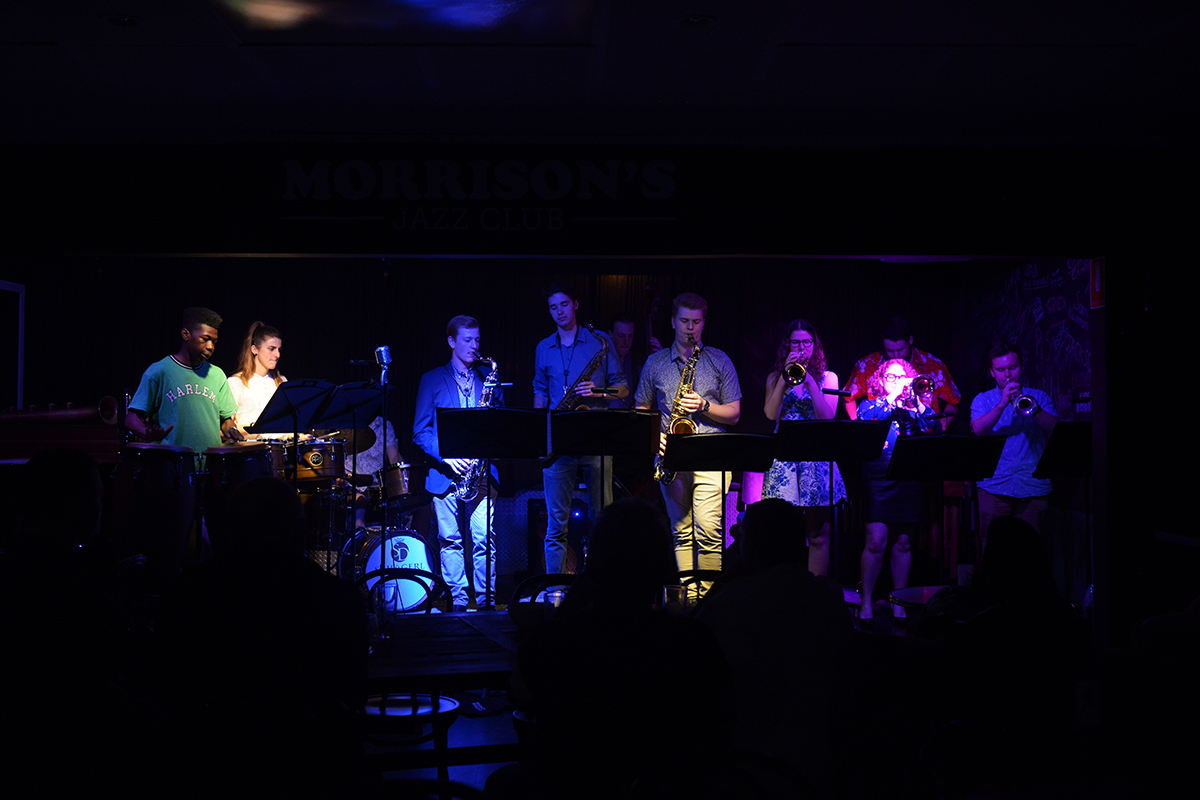

Fun’s changed in Mount Gambier and Morrison’s Jazz Club is where that’s most prevalent.
A smiley waitress takes our empty glasses.
“You’re the photographers,” she half-asked, half-stated. I’d phoned Dan ahead of our arrival to make sure it was okay to photograph the musicians and, spotting the photographer’s Nikon, the waitress had drawn her own conclusions.
The waitress’ name is Ella, she’s in fourth and final year at the Academy and just handed up her thesis last week. Tonight she’s at the club, working, but also filling in on percussion for her peers. Ella moved to Mount Gambier from Sydney, but once she graduates, she said she’s liable to head on over to Melbourne where the rest of her band – Ekki and the Scatterbrains – are.
The lights dimmed and Ella put our glasses in the dishwasher before jumping up on stage with about eight other musicians.
You don’t get more authentic than that. The bartender plays trumpet and the waitress fills in on percussion at Morrison’s Jazz Club. We can’t help but wonder – while we sip our second margarita – if this place is really real.
Flopping on the bed, back at the Mount Gambier Hotel, it’s nice to have such a large room all to myself after spending a big chunk of the day driving. The room has an authentic sort of luxury/vintage feeling, with carved timber mirrors and furniture, a king-sized bed, a giant writing desk, and large bathroom.


Day two
I discovered in the morning that the photographer’s room was even bigger again. It had a kitchenette and large bathroom separated from the bed. It felt like a place you could live in for a week. The dream of being one of those writers who permanently lives and works out of a hotel room flashed before my eyes.
If you’re considering a trip to Mount Gambier with friends, you should definitely book rooms 11, 12, and 13 as this gives you one end of the Mount Gambier Hotel all to yourselves.
After checkout we’re in need of caffeinating. We searched “good coffee Mount Gambier” but it turned out Bricks & Mortar on Wehl Street North did coffee better than many cafés in Adelaide.
They had it all set up: single origin, cold drip, pour over, espresso, batch brew and non-cow milks. Bricks & Mortar had only been open two months.

I ordered a pour over and the photographer a half latte. The girl taking our order doesn’t bat an eyelid. Bricks & Mortar owner, Peter Loring filled us in on why he’s here.
“I worked in forestry for 12 years before this,” Peter told us. He started the business with his wife, Simone, after initially launching a wholesale coffee roasting business six years ago.

L-R: Bailee Murray, Pete Loring and Rob Loring
“Mount Gambier is no-one’s little brother. Melbourne doesn’t want us and Adelaide doesn’t want us, but there’s a lot of scope for new things and more coffee things too. We felt the time was right and we’re just passionate about bringing good coffee to Mount Gambier,” said Pete.
And Mount Gambier is glad for Pete and his team’s efforts. While we were there the door set to swinging at about 7:45 and a little line formed with customers all wanting coffee by 8:00AM.
We could have had several more coffees and just hung out, but we had to hit the road if we were going to make our next stop – Naiko Retreat in the stunning Deep Creek region of the Fleurieu Peninsula – before nightfall.
On our way out of town we spied a healthy-looking eatery called Presto, and pulled over to see if we could get something green to go.
But once we got inside, we realised we needed to stay a while.
With all due care, myself and the photographer apologised profusely for the fact we were going to have to photograph our meals when they came out. But it’s no worries, Presto understands all about the aesthetic economy. Before we’ve finished eating, we see the manager, conducting her own photo shoot out the front. That’s smart! Natural light and a little bit of branding = Instagram 101.
Presto is another new business that’s shifting the shape of Mount Gambier and evidence fun’s changed in South Australia’s regions. Presto has expanded twice in as many years, and the bright, airy café now occupies three shopfronts in the middle of town. It’s heaving at 09:00AM.
The plant-based tilt of their menu resonates with the photographer and me since we are still kind of stuffed from the previous night’s family-sized pepperoni pizza. Some sautéed asparagus and leafy greens, avocado and a poached egg, alongside house-made baked beans were all the things I needed for the drive from Mount Gambier to Deep Creek.


Flake at the Normanville fish and chip shop
I order a second coffee – to go – and we hit the road.
Maria phoned us when we were about an hour away from Deep Creek just to see how we were travelling. We’d just picked up two pieces of local-caught gummy shark and chips from the Normanville Fish & Chip shop and we couldn’t thank her enough for that suggestion.
Maria is the owner of the incredible Naiko Retreat – a stunning three-bedroom shack-palace hybrid cut into the mountainous earth that plunges into Backstairs Passage.
Naiko Retreat is at the end of a road that’s at the end of another road in the depths of Deep Creek. It is an isolated resort with its own private beach; one of Matti Suuronen’s Futuro structures, at least 500 kangaroos and a couple of sheep, and the best thing – not a single other human.
South Australia looks different when you look at it from the balcony of Naiko Retreat.
Fun’s definitely changed for me, I thought, as I ran the bath and stared absentmindedly at the private bay through floor-to-ceiling windows. A good soak is the best thing for unwinding after 10 hours on the road (and a couple of backflips into Little Blue Lake) in the last 36 hours.
Sinking into the tub, I heard the photographer hollering as he frantically ran about the property like a kid in a candy store. There are no bad angles of that place, from the polished concrete floors and beautiful fixtures of the environmentally sensitive and architecturally marvellous house. And then there was the 360º view taking in the chubby hills behind us, right around and across the passage to Kangaroo Island.
I let the photographer know where the key to the car was. He wanted to drive around to the other side of the property to capture the sunset.
As I heard the car zoom off, I sought to lower my eye line to the rim of the bath so that it would line up with the sun. Reflecting on the party atmosphere of last night in Mount Gambier, it was nice in that moment to have nothing else to do but follow the sun and sink into the bubbles of my bath as it seeped into the fairy floss clouds over KI. The whole western sky turned a musk-stick shade of pink.

Bed, bath and beyond

The shack-palace aesthetic of the quintessentially South Australian, Naiko Retreat

Your very own private beach at Naiko Retreat

A one-of-a-kind view

Dreamed up in Finland and shaped like a flying saucer, Matti Suuronen’s ‘house of the future’ or – Futuro House – is a structure that pops up all over the globe. I believe there are as few as 100 that exist in the world. Here’s one in the most unlikely of places.
Day three
Maria has left us an avocado and fresh eggs in the fridge along with a loaf of bread on the bench for breakfast.
Out on the deck at Naiko Retreat, the sound of the ocean rubbing against the ancient shoreline below and the slow, silent and steadfast progress of the SeaLink ferry between Cape Jervis and Penneshaw in the distance, makes this smashed avocado a breakfast not even Bernard Salt would begrudge us. The simple dish elevated beyond Michelin standard purely because of the one-in-a-million setting.
I watched the sea mist lift off of KI and hang like a silk shawl around the island’s shoulders, the smell of salt rose on the air and daylight illuminated the extraordinary topography all around me – everything works together to make Naiko Retreat a world class experience.
Stuff the Mediterranean and all those bragging photos of boats and rocky beaches. I’d rather turn off my mobile phone and float in my own private beach for a weekend in Deep Creek than crowd into another version of someone else’s borrowed holiday.
In many ways Naiko Retreat defines what’s changed about South Australia’s regions and it makes you proud to see just how much people like Maria are helping to challenge the status quo here. While locals – like that cop – might not see it straight away, there is incredible beauty here if you take another look.
Feeling all floaty and nice after spending the night at Naiko, the photographer and I plan our third and final day.
We’ve heard Mitolo has a new head chef and menu, while Gemtree winery has just unveiled their Subterra Shiraz project and offer unique eco-styled tastings on their property.
A lazy day in McLaren Vale seems like the perfect way to close out the trip.

Melissa and Mike Brown
CityMag has long chronicled the rise and rise of the natural wine movement in the Adelaide Hills, but I was excited to discover Gemtree in McLaren Flat had been organic and biodynamic since 2007. While most of the small producers in the hills don’t offer a cellar door experience – Gemtree has a full gamut of experiences and opportunities to learn about biodynamic farming processes at their cellar door on Elliott Road, McLaren Flat. They were also named 2019 Global Winner for Sustainable Wine Tourism Practices, just to make it official.
Fun’s changed, even in a place as familiar as McLaren Vale.
We rang the Gemtree cellar door while making a stop at the Delamere General Store. The photographer wanted a snack and came back with a Chomp bar for me. How good are Chomps?!
The manager said we were in luck, the bosses would be in when we were due to call by. And so Mike and Melissa Brown and Luna (the dog) were there to greet us at the cellar door when we arrived about an hour later. We’d managed to catch them at a rare moment on site, and with enough time to walk us through their incredible operation.
“In 2006 we went organic and in 2007 we went biodynamic,” said Mike as we walked down the sloping lawn towards a fenced-off and intriguing-looking area of the property.
The Gemtree story goes that Melissa’s father and owner of the vines, Paul Buttery, was skeptical about organic farming and wanted assurances Melissa and Mike’s plan to go chemical-free wouldn’t impact the bottom line of his own business as the fruit supplier. Mike and Melissa made good on those assurances and this year celebrated one of their most ambitious projects yet.
“The Subterra Shiraz was an idea of mine to really live our brand and tell our story,” said Mike. “We buried a barrel of our shiraz under the vines last year for eight months, dug it up and decanted it in bottle for a further 11 months and finally released the wine in limited quantities last week.”
“This is a wine made in the vineyard,” Mike said with emphasis.
~
Gemtree are a huge part of the reason why such a significant portion of McLaren Vale fruit is farmed organically. Melissa is the chief viticulturist and it was after a yoga retreat that she returned home and told Mike she wanted to turn the family vineyard organic.
“That was over a decade ago,” said Melissa.
“And now we’re truly starting to see the difference the change in those farming practices has made in the wine we’re able to produce today,” said Mike.
With a couple of bottles under our arm – a couple of favourites from our tasting – we promise Mike and Melissa we’d come back for their wine and wander experience.
Driving away from Gemtree, I felt embarrassed I’d never visited before, and that I didn’t know Mike or Melissa until now.
It’s easy to think you know it all, that you’ve seen it all and nothing’s changed – even in your favourite wine region – but that’s wrong.

‘Endless Journey’ artwork by Ricardo Gonzalez, 2019
The last time I was at the Mitolo Wines cellar door in McLaren Vale was for a friend’s 30th birthday. Mitolo was doing a serious, degustation-style menu with close-to silver service presentation back then.
Rocking up today, I could tell the restaurant had reconsidered its offering. “Endless Journey” was emblazoned across the chic, black façade.
“We did some strategy work with BAD, our creative agency,” said Frank Mitolo, owner of Mitolo Wines.
“We felt like we were a little bit uptight here, so we wanted to do something to undo the top button, make people feel a little more relaxed here – still be premium – but we thought a bit of an art installation would be a good signal that things have changed here,” Frank told us.
The calligraphy on Frank’s façade (and inside) is by New York artist Ricardo Gonzalez who paints under the moniker IT’S A LIVING. Ricardo has worked with brands like Nike, Apple, Google and Coca-Cola and paints using a hybrid analogue-digital process.


Chef, Vincenzo La Montagna
“We’re not sitting still,” said Frank. “The ‘endless journey’ is really what it’s about. This food we’re doing now may not be the same in three years time. It will evolve. But I’m quite excited by the format – it’s quite chilled, I guess we’ve got no rules too. You can eat a la carte, or try the ‘feed me’ menu, La Panada – traditionally over 10 hours and featuring 40 dishes – ours will be over 3-4 hours.”
The photographer and I don’t have four hours and neither does Frank, if we’re honest. What we do have time for is more conversation and some shared plates. Frank orders some of his favourite items off the new menu by chef Vincenzo La Montagna – formerly of Vincenzo’s Cucina Vera.
Wood oven baked pita arrives like a balloon at our table, round and with steam still rising. It’s hot and fluffy when Frank bursts the bubble and cuts open the bread for us to sample. Next comes a plate of warm mortadella – it’s got a citrus note and is so delicate and delicious by itself, but once the caciocavollo (wood-smoked stretched curd) arrives we cannot help but use the pita, mortadella and smoky curd to create tiny ham and cheese sandwiches.
Frank laughs when he sees what we’re doing. Fun’s changed now there’re no rules at Mitolo Wines.
This article was produced in partnership with the South Australian Tourism Commission.
See how fun’s changed in the south east, visit SouthAustralia.com to take another look and find everything you need to book your summer holiday in one of our regions.
